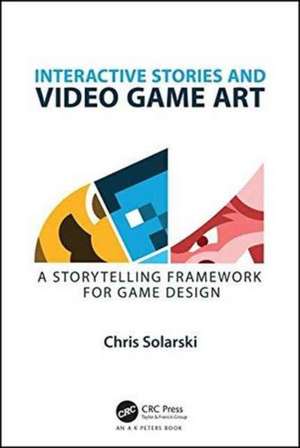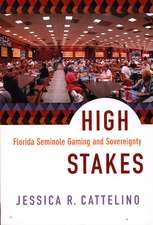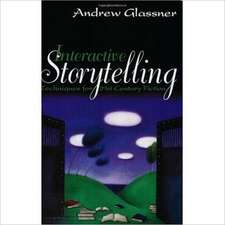Interactive Stories and Video Game Art: A Storytelling Framework for Game Design
Autor Chris Solarskien Limba Engleză Paperback – 17 ian 2017
Key Features:
- The first book to define a common visual and interactive language for understanding and orchestrating sophisticated stories in video games
- Accessible to industry professionals as well as non-developers
- Featured concepts apply to all media with an interactive component including: transmedia, gamification and interactive art
- The definitive framework for designing interactive stories
| Toate formatele și edițiile | Preț | Express |
|---|---|---|
| Paperback (1) | 311.19 lei 3-5 săpt. | +16.71 lei 4-10 zile |
| CRC Press – 17 ian 2017 | 311.19 lei 3-5 săpt. | +16.71 lei 4-10 zile |
| Hardback (1) | 849.77 lei 6-8 săpt. | |
| CRC Press – 18 ian 2017 | 849.77 lei 6-8 săpt. |
Preț: 311.19 lei
Preț vechi: 388.98 lei
-20% Nou
Puncte Express: 467
Preț estimativ în valută:
59.55€ • 62.04$ • 49.52£
59.55€ • 62.04$ • 49.52£
Carte disponibilă
Livrare economică 21 ianuarie-04 februarie 25
Livrare express 04-10 ianuarie 25 pentru 26.70 lei
Preluare comenzi: 021 569.72.76
Specificații
ISBN-13: 9781498781503
ISBN-10: 1498781500
Pagini: 220
Ilustrații: 189
Dimensiuni: 156 x 234 x 12 mm
Greutate: 0.38 kg
Ediția:1
Editura: CRC Press
Colecția A K Peters/CRC Press
ISBN-10: 1498781500
Pagini: 220
Ilustrații: 189
Dimensiuni: 156 x 234 x 12 mm
Greutate: 0.38 kg
Ediția:1
Editura: CRC Press
Colecția A K Peters/CRC Press
Public țintă
Professional Practice & DevelopmentCuprins
Chapter 1 Character Shapes and Poses
Chapter 2 Character Animations
Chapter 3 Environment Shapes
Chapter 4 Pathways
Chapter 5 Framing
Chapter 6 Player Gestures
Chapter 7 Transitions in Games
Chapter 8 Transitions With Cutscenes
Chapter 9 Reiteration of Context
Chapter 10 Transition Hazards
Chapter 11 Transitions Without Cutscenes
Chapter 12 Transitions in Open World Games.
Chapter 2 Character Animations
Chapter 3 Environment Shapes
Chapter 4 Pathways
Chapter 5 Framing
Chapter 6 Player Gestures
Chapter 7 Transitions in Games
Chapter 8 Transitions With Cutscenes
Chapter 9 Reiteration of Context
Chapter 10 Transition Hazards
Chapter 11 Transitions Without Cutscenes
Chapter 12 Transitions in Open World Games.
Notă biografică
CHRIS SOLARSKI is an artist-game designer and author of the seminal book,Drawing Basics and Video Game Art: Classic to Cutting-Edge Art Techniques for Winning Game Design(Watson-Guptill 2012), which has been translated into Japanese and Korean. Chris’ professional background—which mixes game art development at Sony Computer Entertainment and fine art figurative painting—has led him to lecture on emotions and storytelling in video games at international events including the Smithsonian Museum's landmarkThe Art of Video Gamesexhibition, SXSW, Game Developers Conference, and FMX. Chris’ personal projects at Solarski Studio continue to explore the intersections between video games, classical art and film to develop new forms of player interaction and emotionally-rich experiences in games.
Recenzii
"The convergence of narrative in film, video games, and virtual reality will fundamentally change the entertainment industry in coming years. Chris Solarski’s book gives content creators crucial insights into interactive story composition and how to adapt these concepts for transmedia storytelling."
—Marc Forster, Film Director and Producer
"The clever thing about this book is that it bridges the worlds of game design and storytelling. I would recommend this to anyone who wants to get into game design and understand what’s going on beneath the surface. It reminds me of Robert McKee’s Story, the classic book on screenwriting. You read it and you think: Aha, this is how storytelling works in film, it really can be explained! And you can see this book as a companion volume that is essentially doing the same thing for games."
—Tom Standage, Deputy Editor and Digital Strategist of The Economist and a New York Times Bestselling Author
"As a gamification designer you look for inspiration from multiple sources to create behavior-change and evoke emotions that help your audience make decisions. Chris Solarski captures brilliantly how dynamic composition techniques for transmedia storytelling can assist in reaching your audience through shapes, flow, positioning and much more."
—An Coppens, Chief Game Changer at Gamification Nation Ltd.
"Interactive Stories and Video Game Art touches upon factors that can be a barrier to the developers’ experience being actualised: managing player attention, dealing with memory, communicating how players should think about playing, in addition to the practicalities of play. I feel I have a more robust means of assessing the experience developers are aiming to achieve as a result of these guidelines. The contractual nature of my work also means that I’m tasked with quickly communicating the design intent between the dev team and my team. The visual communication symbols presented in each chapter are sure to play a part in that process moving forward."
—Seb Long, UX Researcher at Player Research
"As a game designer, I think Interactive Stories and Video Game Art is a must-read. I love how Chris Solarski puts game design and gameplay at the centre of the whole artistic process, so everything is easily applicable to any project and to both sides of development, to game design and graphics."
—David Javet, Narrative Designer and Co-founder of Tchagata Games
"This book is an eye-opener. I haven't been in the games loop for a while, but it transcends games. Reading it made me feel what I felt when I first studied cinematography."
—Gustavo Sánchez-Perez, FX Artist at Mr. X
"Chris Solarski's book is extremely ambitious; from the smallest detail to broad concepts that encompass an immense scale, its truly applied methodology serves as a catalyst that enriches the reader's heart and promotes the creation of pure art."
—Erik Anzi, Producer, Screenwriter, and Concept Artist on films including Ridley Scott's Alien and Blade Runner
"The concepts presented inInteractive Stories and Video Game Artremind me of Joseph Campbell's powerful demonstration of a universal storytelling structure. Coming from a technical game design background yet being artistically inclined, I never considered that atomic elements such as shapes, lines of movement and transitions contain a vocabulary strong enough to sculpt our mood, whether consciously or unconsciously. This book creates that wonderful feeling of learning new letters, which soon prove useful to form sentences for bringing new poetry to the world."
—Stéphane Assadourian, Veteran Game Production Consultant and founding member of Ubisoft's Assassins' Creed franchise
—Marc Forster, Film Director and Producer
"The clever thing about this book is that it bridges the worlds of game design and storytelling. I would recommend this to anyone who wants to get into game design and understand what’s going on beneath the surface. It reminds me of Robert McKee’s Story, the classic book on screenwriting. You read it and you think: Aha, this is how storytelling works in film, it really can be explained! And you can see this book as a companion volume that is essentially doing the same thing for games."
—Tom Standage, Deputy Editor and Digital Strategist of The Economist and a New York Times Bestselling Author
"As a gamification designer you look for inspiration from multiple sources to create behavior-change and evoke emotions that help your audience make decisions. Chris Solarski captures brilliantly how dynamic composition techniques for transmedia storytelling can assist in reaching your audience through shapes, flow, positioning and much more."
—An Coppens, Chief Game Changer at Gamification Nation Ltd.
"Interactive Stories and Video Game Art touches upon factors that can be a barrier to the developers’ experience being actualised: managing player attention, dealing with memory, communicating how players should think about playing, in addition to the practicalities of play. I feel I have a more robust means of assessing the experience developers are aiming to achieve as a result of these guidelines. The contractual nature of my work also means that I’m tasked with quickly communicating the design intent between the dev team and my team. The visual communication symbols presented in each chapter are sure to play a part in that process moving forward."
—Seb Long, UX Researcher at Player Research
"As a game designer, I think Interactive Stories and Video Game Art is a must-read. I love how Chris Solarski puts game design and gameplay at the centre of the whole artistic process, so everything is easily applicable to any project and to both sides of development, to game design and graphics."
—David Javet, Narrative Designer and Co-founder of Tchagata Games
"This book is an eye-opener. I haven't been in the games loop for a while, but it transcends games. Reading it made me feel what I felt when I first studied cinematography."
—Gustavo Sánchez-Perez, FX Artist at Mr. X
"Chris Solarski's book is extremely ambitious; from the smallest detail to broad concepts that encompass an immense scale, its truly applied methodology serves as a catalyst that enriches the reader's heart and promotes the creation of pure art."
—Erik Anzi, Producer, Screenwriter, and Concept Artist on films including Ridley Scott's Alien and Blade Runner
"The concepts presented inInteractive Stories and Video Game Artremind me of Joseph Campbell's powerful demonstration of a universal storytelling structure. Coming from a technical game design background yet being artistically inclined, I never considered that atomic elements such as shapes, lines of movement and transitions contain a vocabulary strong enough to sculpt our mood, whether consciously or unconsciously. This book creates that wonderful feeling of learning new letters, which soon prove useful to form sentences for bringing new poetry to the world."
—Stéphane Assadourian, Veteran Game Production Consultant and founding member of Ubisoft's Assassins' Creed franchise
Descriere
This book defines a common design language used to understand and orchestrate video game storytelling. Building from a foundation of art forms such as ancient Greek sculpture, classical painting, and film, this book defines a language that is mindful of gaming’s principal relationship between player actions and video game art. Brief examples from film will set the stage for examining the do’s and don’ts of storytelling techniques for various video games, including The Last of Us, Journey, Minecraft, and the Grand Theft Auto series. This book is for developers of video games and virtual reality, filmmakers, gamification and transmedia experts.


















